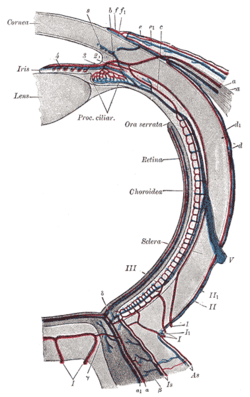Vorticose veins
| Vorticose veins | |
|---|---|
 The veins of the choroid. (Venae vorticosae labeled - though difficult to see - at center.) | |
 Diagram of the blood vessels of the eye, as seen in a horizontal section. ("V", at center right, is the label for the vena vorticosa) | |
| Details | |
| Drains to | inferior ophthalmic vein, superior ophthalmic vein |
| Artery | short posterior ciliary arteries |
| Identifiers | |
| Latin | venae vorticosae |
| TA | A12.3.06.106 |
| FMA | 70880 |
The vorticose veins, referred to clinically as the vortex veins, drain the ocular choroid. The number of vortex veins is known to vary from 4 to 8 with about 65% of the normal population having 4 or 5.[1] In most cases, there is at least one vortex vein in each quadrant. Typically, the entrances to the vortex veins in the outer layer of the choroid (lamina vasculosa) can be observed funduscopically and provide an important clinical landmarks identifying the ocular equator. However, the veins run posteriorly in the sclera exiting the eye well posterior to the equator.
Some vortex veins drain into the superior orbital veins and thence to the cavernous sinus. Some vortex veins drain into the inferior orbital vein which drains into the pterygoid plexus. There is usually collateral circulation between the superior and inferior orbital veins.
Additional images
 The blood-vessles of the eyeball (diagrammatic).
The blood-vessles of the eyeball (diagrammatic).
References
This article incorporates text in the public domain from the 20th edition of Gray's Anatomy (1918)
- ↑ Kutoglu, T., Yalcin, B., Kocabiyik, N. and Ozan, H. (2005), Vortex veins: Anatomic investigations on human eyes. Clinical Anatomy, 18: 269–273. doi:10.1002/ca.20092